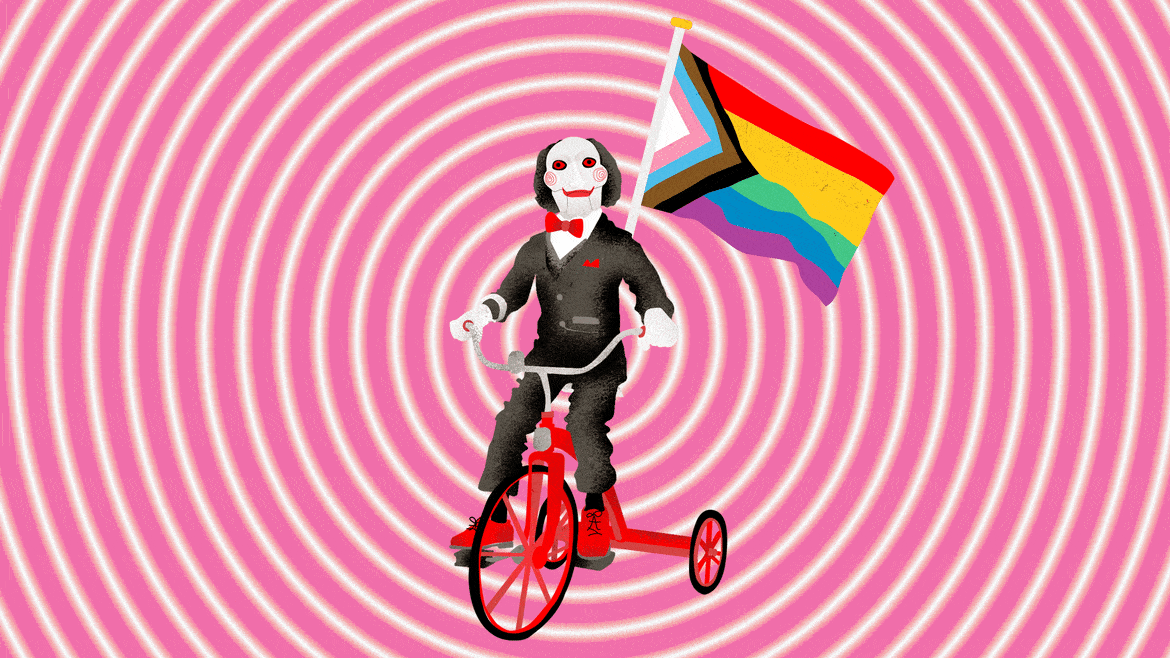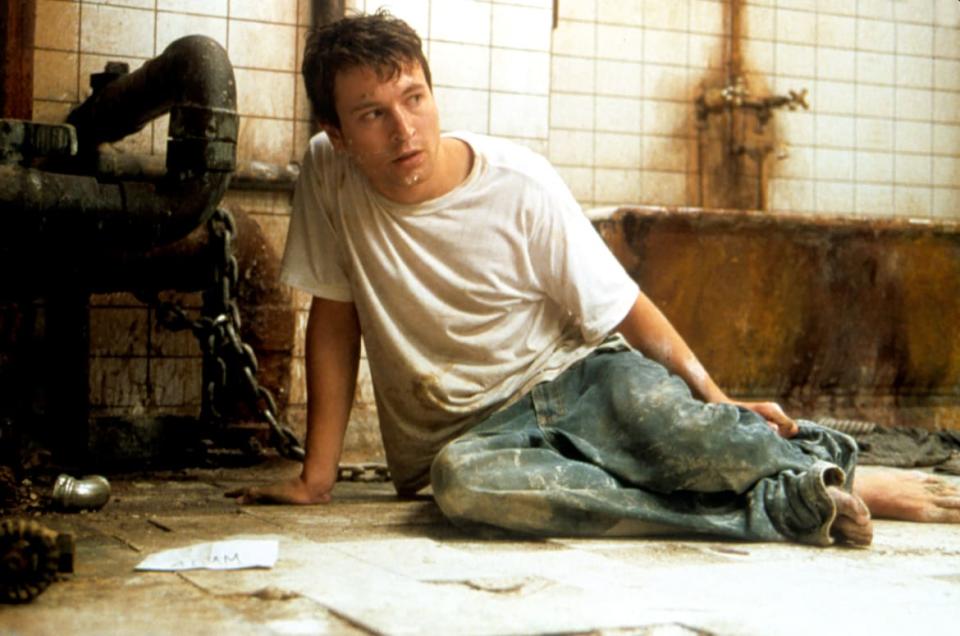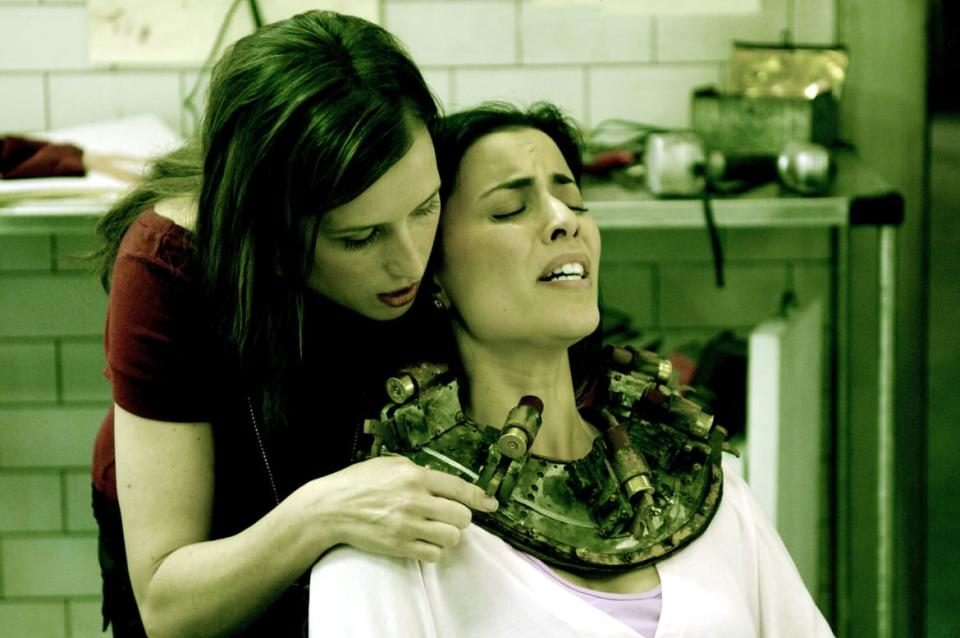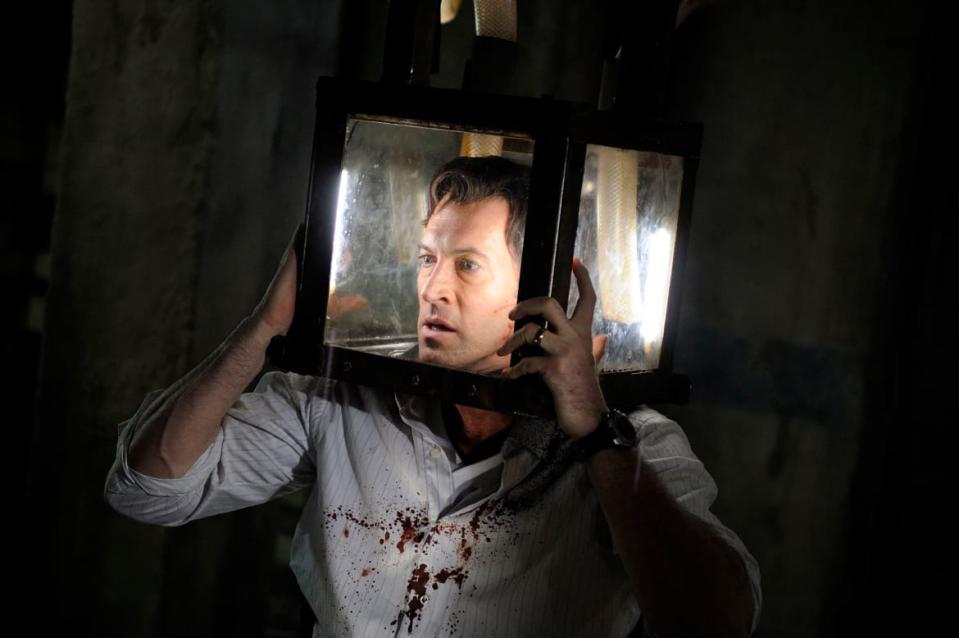To ‘Saw’ Fans, the Movies Aren’t Just Scary—They’re Delightfully Queer

- Oops!Something went wrong.Please try again later.
Since the first film debuted in 2004, the Saw franchise has become infamous for its brutality. To many of the franchise’s fans though, the precarity of life is what allows the story to give way to a franchise about found family and queerness. And despite the story of Saw originally coming to a close in 2010—despite two recent “sequels,” the newly released Saw X is the first canonical entry since then—a younger, queer, and very online audience is reframing the narrative around these infamous films entirely.
The emergence of a fresh, queer take on Saw seems to have happened over the pandemic, with the majority of TikToks and fanfics about its characters gaining popularity then. In the seclusion of their homes and rooms, younger fans watching (and re-watching) a horror franchise have had a chance to see it as something older viewers wouldn’t expect: very queer. These fans found the series as it was wrapping up, when inklings of queerness were just little anecdotes to brush aside and address later. Now older, fans like myself are able to revisit the films and finally see ourselves in these lost characters, albeit treating them with more care in our heads than the actual franchise does. In doing so, the queer fandom’s presence has become the dominating force behind the franchise’s revival.
“I do think a significant factor in the franchise’s longevity has been the queer community’s relation to it, and I think whoever is behind Lionsgate’s marketing is finally beginning to recognize that fact,” says Alex, a 28-year-old with a background in forensic psychology who first watched the films in 2016 with her best friend.

Leigh Whannell in Saw.
It’s true: Just before the release of Saw X, the series’ official Twitter account collaborated with PopCrave, doing a takeover of the popular news account’s profile and partaking in a Q&A. It’s clear that the marketing team knows who is responsible for the online memes surrounding the franchise, and the Saw social media pages interact with fans who are doing watch parties and creating fan art. It's charming to see the people behind the franchise interact with the fans who have given the series such a popular revision.
But watching the films doesn’t immediately suggest such a fun online presence. Each film sees its villain, Jigsaw (also known as John Kramer), forcing people who he believes don’t cherish their life to literally fight their way back into the world of the living. Oftentimes, these people are trapped in an elaborate maze filled with varying obstacles that force them to mutilate their skin and even sever body parts. In reckoning with the precarious nature of their flesh, Jigsaw hopes that the subjects he chooses will, in the end, realize how sacred life is.
With its emphasis on gory kills, the franchise has gotten a lot of flack for igniting the “torture porn” genre. But that’s not quite right: While the later films, especially the horribly misogynistic Saw 3D, seem to revel in the on-screen violence, the earlier entries are a different case entirely. Entries one through three work as their own trilogy, feeling at times more like thrillers than horror films. They are also more character-based, focusing on Jigsaw, his victims, and his disciples. “The fact that Saw is called ‘torture porn’ is something… I think the film got that label from the sequels, as they got more and more gory,” said writer (and star of the first film) Leigh Whannell, when asked about the moniker in a 2014 interview.
In being the sole films in the series to trade in blood and gore for character drama, the initial Saw films have garnered a unique reputation over the years. Now, almost two decades after Saw’s release, a younger generation of fans have popularized a surprising queer reading of the films, one that focuses on Jigasaw’s apprentices in a character-based fashion. New fan art and fanfiction featuring each apprentice in a different queer relationship, one that brings them a sense of freedom, appear online multiple times a week—and their growing popularity should encourage you to rewatch the movies with a new perspective.

Cary Elwes in Saw.
Revisiting Saw with this queer lens, the subtext begins to flow—particularly through the two main characters (and Jigsaw victims), Adam (Leigh Whannel) and Lawrence (Cary Elwes). “I think they’re probably one of the most obviously queer-coded pairings in horror to date,” says Alex. Their relationship in the first Saw film plays out like a classic enemies-to-lovers arc: Adam is a disgruntled young man who smokes, swears and listens to what sounds like a bad Nine Inch Nails tribute band. Lawrence, on the other hand, is an older doctor who is having an affair with a woman he works with to cope with his midlife crisis. The two couldn’t be any more different, yet because of Jigsaw, they are forced together to not only escape the bathroom trap, but help each other do so.
At the end of it, they are left gasping and bloody, clutching onto each other like a lifeline. It’s a shot that evokes romantic epics like Titanic, and the desperation on each of their faces is jarring for a film that has a reputation for birthing the “torture porn” subgenre. Even in Saw The Musical: The Unauthorized Parody of Saw, the two characters still have this unwavering sexual chemistry—enhancing the subtext that already existed.
Adam and Lawrence’s fates are intrinsically linked, and fans have latched onto them accordingly. Since the film’s 2004 debut, the Adam and Lawrence pairing has become known as “Chainshipping,” with the first fanfiction for the pairing uploaded on Fanfiction.net in 2007. Since then, the pairing has amassed 638 written fanworks on Archive of Our Own (AO3), with new ones uploaded almost each day of the month of September. Many of these stories involve Adam surviving the trap—Saw II confirms he met his demise in that bathroom—as he and Lawrence attempt to heal from their time under Jigsaw’s torment.
“Their situation offers an opportunity for so much ‘what could have been’ theorizing with endless possibilities, which has given the franchise further appeal and relevance to the LGBT+ horror fanbase,” says Jay, a key art designer from London. Since 2020, he has logged the first film six separate times on Letterboxd, each watch accompanied by a hilarious review; he’s done the same for several other films in the series.
Like most fandoms, while the two male pairings are undoubtedly the most popular, queer fans have also glommed onto Amanda (Shawnee Smith), one of Jigsaw’s apprentices, whose arc from Saw onward cannot be overlooked. “I think a lot of people overlook the queerness of her narrative in favor of Adam [and] Lawrence,” says Alex of Amanda’s appeal. “Her story begins with her stuck in this sort of performatively feminine space—short skirt, long hair—that serves as a means to an end.” This is especially true in later Saw films, when we see flashbacks to Amanda’s life as a drug addict. She relies on the attention men give her, as a means to exchange the drugs she consumes. To her, the long hair and the feminine clothing act as a disguise, hiding her true more masculine self from the people she is forced to be around.
In Saw II, Amanda looks visibly different, shedding her old self for a new, more confident one under John’s influence. Alex agrees, stating that when she’s reintroduced, “[Amanda] has traded the long hair for a short, choppy look (hilariously reminiscent of Shane from The L Word) she seems to have gained a sense of confidence that [she didn’t have] in the first film.” Amanda’s transformation, Alex says, “is not at all dissimilar from coming out.” In finding a purpose as Jigsaw’s apprentice, her story arc begins to mirror that of queer people finding a new identity.
The third film is where Amanda is finally allowed to be a fully realized character, making fans’ queer headcanon able to blossom. Like Adam and Lawrence in the first film, Amanda as Jigsaw’s apprentice is essentially paired up with one of his victims, a doctor named Lynn who is given the grueling task of performing an at-home brain surgery on the sickly mastermind.

Shawnee Smith, left, as Amanda in Saw III.
Amanda’s resolve begins to waver around Lynn, almost as if spending time with her is the final piece of the puzzle that is Amanda’s sexuality. She becomes increasingly unhinged as the film goes on, misdirecting all of her anger toward Lynn instead of John. Here, Amanda’s story becomes a classic representation of the internal struggle queer people go through, pulled between the life she had before Saw II and one where she could fully be herself. “It was something that made me think a lot about Amanda’s character [and] her sexuality, and how those [two things] come into play with her trap for Lynn,” says Hannah, a student who became a fan of the films when doing a series marathon in 2020.
Though she dies by the end, Amanda’s impact on the community is a close runner-up to that of Adam and Lawrence. Fans have recontextualized and praised her role as time has gone on, holding her up as the franchise’s Mother. The character is a big reason why Alex got into the series in the first place: “Good or bad, the relatability [I had with Amanda’s story] was the initial draw for me.”
Amanda isn’t the only character who has become more popular as the years have gone on. In a shocking turn of events in the last two years, another queer ship has blown up within the fandom—this time between two characters who previously were met with apathy by the fandom. After Amanda and John died in Saw III, the franchise found a new lead in Mark Hoffman (Costas Mandylor), a detective and secret Jigsaw apprentice. He quickly begins to butt heads with an out-of-town special agent, Peter Strahm (Scott Patterson). The two “cannot get enough of each other,” as Jay says; Hoffman and Strahm spend the better part of two films going on a cat-and-mouse chase with each other, dodging each other's questions and fists until ultimately, Strahm is crushed to death in, you guessed it, a Jigsaw trap. Hoffman watches with a grimace, one that fans quickly latched on to.
With Adam and Amanda out of the picture, the introduction of the Mark/Peter dynamic gave queer fans something new to geek out about. On AO3, the pairing stars in 202 works and counting—with most of these being written from 2021 to 2023, pointing to Saw’s recent online resurgence. The relationship between Hoffman and Strahm is akin to that of Hannibal and Will in NBC’s similarly ship-worthy Hannibal, both in the films itself and in the fanworks: A mastermind villain exists right under the nose of the detective that is supposed to be hunting them.

Scott Patterson in Saw V.
Throughout the Saw series, Mark and Peter trade places often, with cat becoming mouse and so on. They hate each other, yes, but they are also inexplicably drawn to each other as well. The two grow closer, even when they both know that the best thing for them would be to stay away. Their hatred for each other contributes to a will-they-won't-they dynamic that lasts for two films, and makes for the perfect inspiration for fanworks where they eventually do succumb to their feelings for each other.
As the franchise goes on, Jigsaw somehow continues to cultivate a group of ragtag queers as his apprentices—or, at least, that’s how the fanbase sees it. To Amanda, Hoffman, and, later, Lawrence (a twist!), John Kramer is something of a queer elder for his disciples. He allows various lost souls who have been discarded by society to find a purpose in playing a twisted kind of god only found within the Saw universe, but by doing so, they find a sense of freedom. Like Jay says, as seen when “Adam and Lawrence finally embrace after 6 hours on opposite sides of the rooms, there’s a longing for human connection” at the heart of each of these twisted characters, no matter how bad they initially seem in Jigsaw’s eyes.
With Saw X taking place between Saw and Saw II, it seems like we may finally be in the right hands. When the first trailer was released, fans rejoiced at seeing more than one familiar face. “I’m genuinely over the fucking moon that Amanda is back,” says Alex. Hannah, however, wants more from the franchise: “If I'm being honest, I’d love to see some of those characters confirmed to be queer or have more queer interactions play out.”
We can only hope that subtext will finally become text in this new rendition (and going forward), but even if it doesn’t, the series will continue to be home to fans that reimagine these brutal films as a franchise about queer characters finding their place in the unforgiving world they inhabit. Over almost two decades, the Saw franchise has gone from being deemed as nothing but torture porn, to cultivating a fandom that shares queer headcanons, fan art, and fanfiction. Although it may be a shocking change of pace from the violence the franchise is known for, when reexamining the early films, there’s no doubt that Saw created a fandom like this.
Get the Daily Beast's biggest scoops and scandals delivered right to your inbox. Sign up now.
Stay informed and gain unlimited access to the Daily Beast's unmatched reporting. Subscribe now.

